#Germanium transistor
Explore tagged Tumblr posts
Video
Vintage Royal Prince Germanium Crystal Radio, Model GR-25, Headphone Only, Made In Japan, Circa Late 1950s by Joe Haupt Via Flickr: This is not my radio or photograph. It is from an e-Bay auction which ended on April 26, 2023. A very similar transistor version of this radio was also made, model TR-125-A.
#Vintage Royal Prince Germanium Crystal Radio#Vintage Crystal Radios#Vintage Royal Prince Model TR-125-A Transistor Radio#Vintage Royal Prince Model GR-25 Germanium Crystal Radio#flickr
2 notes
·
View notes
Text
Skronk Machine by Blammo Electronics - A Modern Zonk Machine?
The Skronk Machine by Blammo Electronics is a contemporary reimagining of the iconic Zonk Machine, tailored for today’s vintage fuzz enthusiasts. This updated version enhances the user experience with smooth, no-click relay switching, versatile passive tone control, and a sleek, pedalboard-friendly design. Skronk Machine Blammo Electronics has crafted the Skronk Machine for fuzz pedal…

View On WordPress
#1960s#fuzz#Gary Hurst#germanium#Instagram#John Hornby Skewes#John Hornby Skewes Zonk Machine#MK1 Tone Bender#MP38a#NOS#NOS germanium MP38a transistors#pedal#Skronk Machine#stompbox#transistors#true-bypass#Zonk Machine
0 notes
Text










Schaller - collection
"For the SCHALLER enthusiasts ... how to differ models
Beside the facts that the early versions had:
•2 screws on top ( first generation),second generation have 1 screw
•both controls to the far right (first generation ), second generation with 1 screw on top have the controls more towards the center, same as the last versions with silicons in the 70s.
•different jack sockets ( last pic shows the very early to the left vs. the last germanium version with 1 top screw but already in a plastic enclosure to the right)
•screw size on the first generation pedals is way smaller; the feet are different as well ( last 2 pics showing the 1st generation to the left vs. the last germanium version to the right)
•very early ones had AC151 germanium transistors while the later ones used Ates AC192 germanium transistors
•version 3 before they swapped to silicon transistors (probably late 69/early 1970) still has one top mount screw but already a PLASTIC enclosure but still the „Marshall-type“ control knobs.
•the „SCHALLER“ engraving changed over the years as well; the very early ones like in pic #2 are big and deep while the letters went smaller till the last versions in a plastic enclosure with silicon transistors, no top-mounted screw and silver metal knobs. Swipe left for the „history“ of the Schaller logo.
•there’re a handful super early ones with the inside NOT painted.
These infos are based on what I’m looking at overbite years collecting these pedals. I didn’t wanted to go deeper as most of the folks who have one at home or wanna buy one aren’t into „science" too much"
cred: facebook.com/Isle of Tone
20 notes
·
View notes
Text
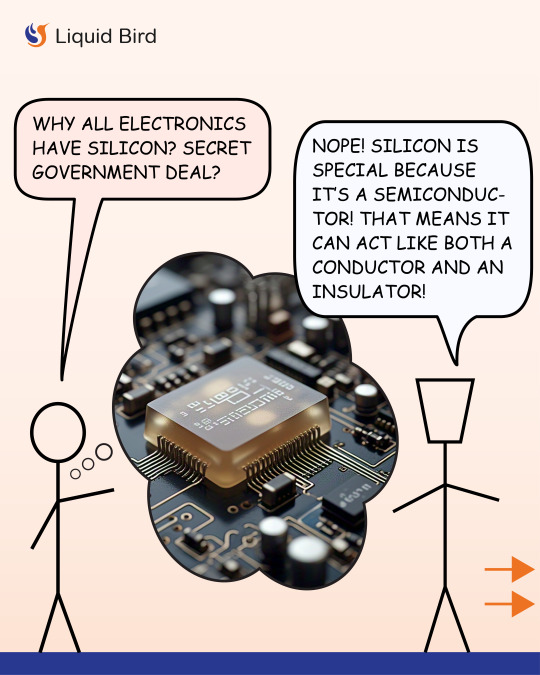
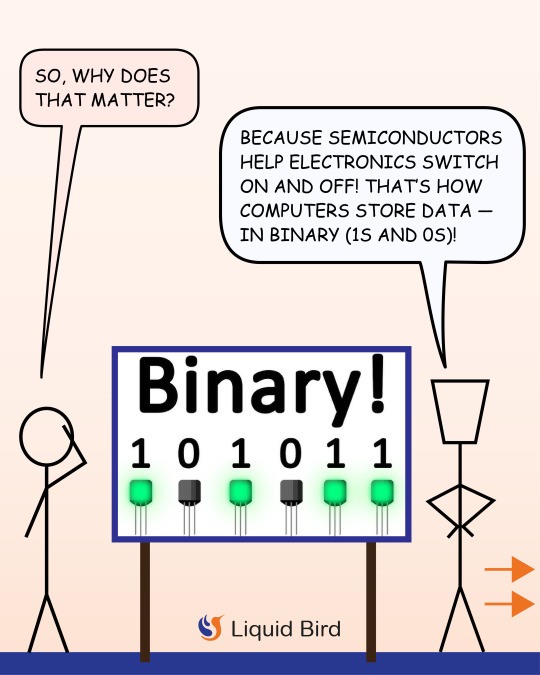

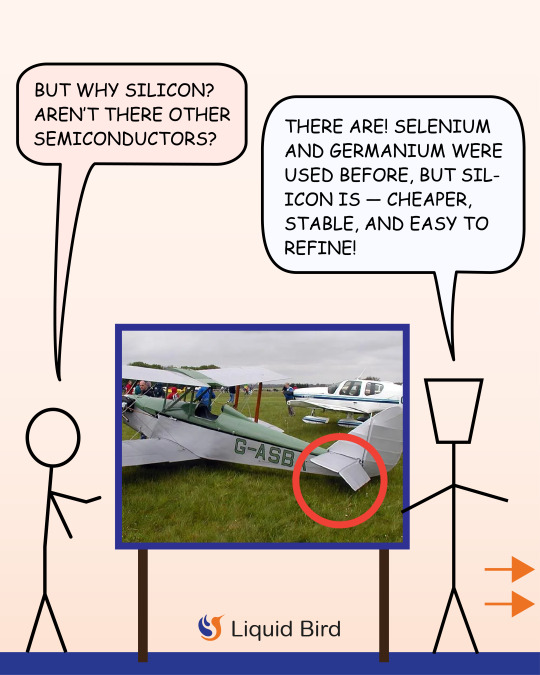


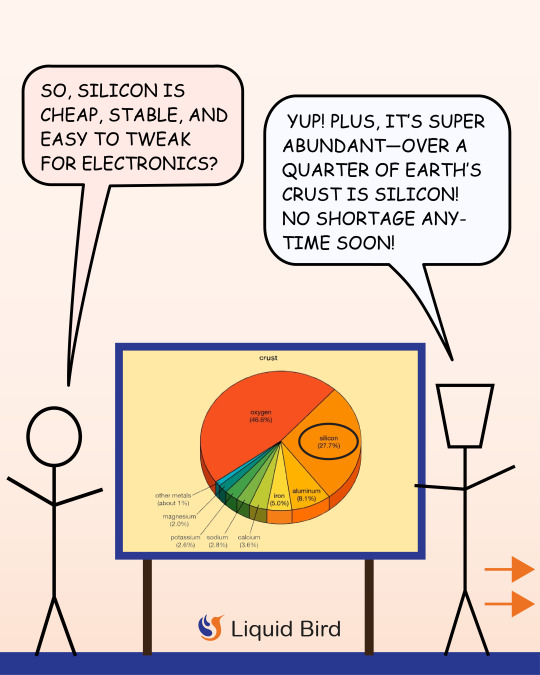



Silicon is the king of electronics, but it wasn’t always that way. In the early days, materials like germanium and selenium were used in making transistors and diodes. Germanium was great because it had high conductivity and worked well in early circuits, but it had one big problem—it couldn’t handle high temperatures. Selenium was used in rectifiers, but it wasn’t as efficient as today’s semiconductors. Then came silicon, and it changed everything.
Silicon became the top choice because it has the perfect balance of electrical properties and stability. It’s a semiconductor, meaning it can act as both a conductor and an insulator, depending on how it’s treated. This makes it ideal for transistors, microchips, and other electronic components. One major advantage is its ability to withstand high temperatures, unlike germanium, which breaks down easily when things heat up. Silicon also has a stable crystalline structure, which makes it reliable for long-term use in circuits.
Another big reason for silicon’s dominance is how easy it is to “dope.” Doping is the process of adding tiny amounts of other elements to change how silicon conducts electricity. By adding phosphorus or boron, engineers can create either n-type or p-type silicon, which are essential for making diodes, transistors, and integrated circuits. This precise control over its conductivity is what makes modern electronics possible.
On top of all that, silicon is incredibly abundant. It’s the second most common element in Earth’s crust, found in sand and quartz. This makes it cheap and easy to source compared to rarer materials. Because of this, silicon-based chips are affordable and mass-producible, making electronics available to everyone.
From the first germanium transistors to today’s advanced silicon microprocessors, technology has come a long way. And thanks to silicon, we have everything from smartphones to supercomputers.
Follow for more such educational content daily!
Check, our substack for more in-depth articles on such topics.
#comics#sciencecomics#webcomics#science#stem#educationalcomics#liquidbird#becurious#comicstrips#rockets#space#electronics#aircraft
5 notes
·
View notes
Text
Reading Notes_Semiconductors and Transistors
Despite studying Computer Science, I have no idea how the intricate parts of a computer work. Needless to say I was thrilled to find out that my current read, Chip War by Chris Miller, covers one of the biggest inventions in the last century, the transistor. So to help myself learn and remember it, here's my explanation.
William Shockley came up with the theory of Solid State Value where if a power source was attached to a piece of silicone and an electric field was applied then, the silicone would then become conductive due to the electrons being attracted. Unfortunately, at the time the tools to detect the current that was being passed were not up to par so, later on Walter Brattain and John Bardeen improved the experiment by applying two gold filaments attached by wires to a power source and a piece of metal to a block of germanium (works in a similar fashion to silicone). Each filament touched the germanium less than a millimeter apart from one another.
They found they were able to control the current that was surging across the germanium by switching the power on and off thus proving Shockley's theory. The new piece of technology was then dubbed the transistor.
Hopefully this will help keep this information in my brain, and maybe teach any other CS professionals.
3 notes
·
View notes
Text



#ThrowbackThursday "The first transistor radio hit the consumer market on October 18, 1954. The Regency TR-1 featured four germanium transistors operating on a 22.5-volt battery that provided over twenty hours of life.
"The unit weighed eleven ounces and cost $49.95.
"Two companies — Texas Instruments of Dallas, Texas, and Industrial Development Engineering Associates (I.D.E.A.) of Indianapolis, Indiana — worked together to produce the Regency TR-1.
"TR-1 COLORS: Four colors were initially offered in the 3" x 5" x 1 1/4" plastic case — Black, Ivory, Mandarin Red and Cloud Gray; and were soon followed by Mahogany and Forest Green. The color selection continued to grow as the TR-1 was marketed as a stylish accessory." — Bruce Eaton, Old Time Radio Lovers on Facebook.
Sources: 1 | 2 | 3
7 notes
·
View notes
Text
:/ tried all the reasonable gain transistors i have for q4 on the fucked up big muff and its still 2 quiet w/ germanium clippers. time to thro the unreasonable transistors at it
#in what world is a 2n5089 not enough gain????????????#w/e time to put a mpsa13 in surely 5000x gain is enough
2 notes
·
View notes
Text
SEMICONDUCTORS
(How India is progressing in this sector)
1.What is a Semiconductor?
Semiconductors are materials which has electrical conductivity ranging between conductors and insulators. Conductors are good conductors of electricity while Insulators are bad conductors of electricity.

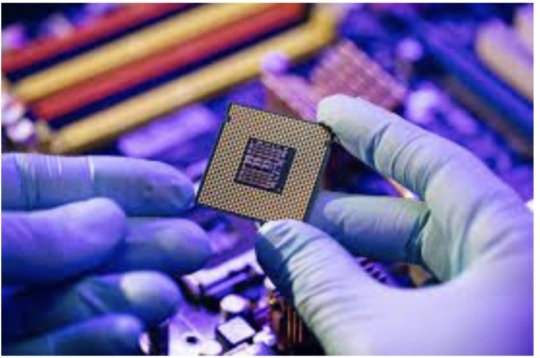
2.Where is a semiconductor used?
Semiconductors are used in manufacture of various electronic devices like diodes, transistors and integrated circuits. The most popular use of a semiconductor is in cars. In vehicles these semiconductor chips are used to control emission systems, driver assist systems etc. Not only in electric cars these chips are also used in petrol cars.

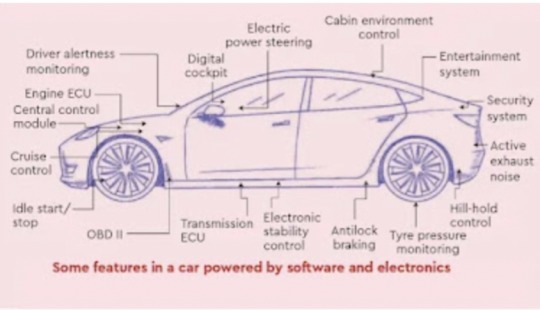
3.A Semiconductor is made up of which material?
Generally a Semiconductor chip is made up of silicon, germanium and gallium arsenide. Out of these three germanium is the oldest.
4.How will a semiconductor help?
First of all semiconductors regulate the flow of electricity and assist in making electronics function. Secondly the electrical conductivity of a semiconductor can be controlled over a wide range making them versatile for various applications. As I told you earlier that a semiconductor is not only used in electric cars but also in petrol cars, this is because semiconductors increase fuel efficiency in cars. By using semiconductors in engine control systems car manufacturers can achieve more precise control of the engine resulting in improved fuel economy and lower emissions.
So these were some common questions people ask when they hear about a semiconductor.
Now you must know that how it will help India and what steps India is taking to manufacture semiconductors in India.
At present Taiwan, USA, Japan, South Korea, China, Israel, Netherlands, UK and Germany can manufacture semiconductors. Out of these countries China and Taiwan produce a large amount of semiconductor.
More exciting thing was that USA and China were in contention with each other in this matter. During era of Donald Trump there aroused a semiconductor war between USA and China. USA wanted to disrupt China's semiconductor manufacturing and hence put a lot of sanctions on China. USA also funded Taiwan and wanted Taiwan to produce more semiconductors than China.

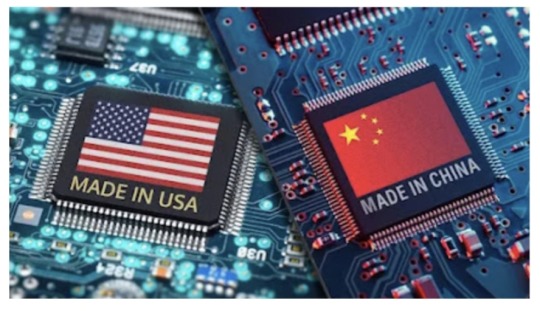
In all this India was benefited a lot. India also wanted to develop semiconductor plants in country and facilitate ATMANIRBHAR BHARAT initiative.
https://ism.gov.in/ this is the link of Government's India Semiconductor Mission. This mission aims at forming a semiconductor ecosystem in India.


Government of India is also working on many other semiconductor initiatives like SPECS initiative. Moreover a joint venture of Vedanta electronics manufacturing giant Foxconn has finalised Dholera Special Investment Region near Ahmedabad for setting up their semiconductor display manufacturing facility.

So much progress is happening in India and surely it will facilitate India's economy and will also provide more job opportunities. India will surely emerge as a Developed nation in upcoming years and these semiconductor initiatives are like a cherry on the cake.
Watch this video for more info.
I hope you liked my article
Pls put forward your views in comment section
Till then PEACE OUT........
My insta : sm_it_22
~Written By Smit.
3 notes
·
View notes
Text
I ran into a video going into the circuit details of the classic Fuzz Face guitar pedal, and was reminded that I need to build my own and got a little excited about it — and then I realized that I'm not entirely sure where I put that stash of germanium PNP transistors that need to be sorted and tested first. Oof. Maybe I should build the tester first, then dig through the boxes of parts.
2 notes
·
View notes
Text
Magnetic Sensitive Transistor Market 2025-2032
The global Magnetic Sensitive Transistor Market size was valued at US$ 124 million in 2024 and is projected to reach US$ 178 million by 2032, at a CAGR of 5.2% during the forecast period 2025-2032
Magnetic Sensitive Transistor Market Overview
The U.S. market size for Magnetic Sensitive Transistors is estimated at USD 120 million in 2024, while China’s market is projected to reach USD 210 million in the same year.
The Germanium Magnetotransistor segment is expected to reach USD 350 million by 2032, growing at a CAGR of 7.2% during the forecast period 2026–2032.
We have surveyed the Magnetic Sensitive Transistor manufacturers, suppliers, distributors, and industry experts on this industry, involving the sales, revenue, demand, price change, product type, recent development and plan, industry trends, drivers, challenges, obstacles, and potential risks This report aims to provide a comprehensive presentation of the global market for Magnetic Sensitive Transistor, with both quantitative and qualitative analysis, to help readers develop business/growth strategies, assess the market competitive situation, analyze their position in the current marketplace, and make informed business decisions regarding Magnetic Sensitive Transistor. This report contains market size and forecasts of Magnetic Sensitive Transistor in global, including the following market information:
Global Magnetic Sensitive Transistor market revenue, 2020-2025, 2026-2032, ($ millions)
Global Magnetic Sensitive Transistor market sales, 2020-2025, 2026-2032, (Units)
Global top five Magnetic Sensitive Transistor companies in 2024 (%)
Receive Your Sample Report at No Cost-https://semiconductorinsight.com/download-sample-report/?product_id=97783
Magnetic Sensitive Transistor Key Market Trends :
Rising Demand in Automotive and Consumer Electronics: Increasing use of magnetic sensitive transistors in automotive sensors and consumer devices is driving market growth.
Shift Towards Silicon Magneto-Transistors: Silicon-based magnetotransistors are gaining popularity due to their cost-effectiveness and better integration with existing semiconductor technologies.
Growth in Contactless and Proximity Switch Applications: The expanding applications in contactless switching and proximity sensing boost the adoption of these transistors.
Advancements in Miniaturization and Sensitivity: Ongoing innovations improve transistor sensitivity while reducing size, enabling use in more compact electronic devices.
Expansion in Asia-Pacific Region: Rapid industrialization and growing electronics manufacturing in Asia-Pacific, especially China and India, contribute significantly to market growth.
Magnetic Sensitive Transistor Market Segmentation :
Global Magnetic Sensitive Transistor market, by Type, 2020-2025, 2026-2032 ($ millions) & (Units) Global Magnetic Sensitive Transistor market segment percentages, by Type, 2024 (%)
Germanium Magnetotransistor
Silicon Magneto-Transistor
Global Magnetic Sensitive Transistor market, by Application, 2020-2025, 2026-2032 ($ Millions) & (Units) Global Magnetic Sensitive Transistor market segment percentages, by Application, 2024 (%)
Magnetic Detection
Contactless Switch
Proximity Switch
Competitor Analysis The report also provides analysis of leading market participants including:
Key companies Magnetic Sensitive Transistor revenues in global market, 2020-2025 (estimated), ($ millions)
Key companies Magnetic Sensitive Transistor revenues share in global market, 2024 (%)
Key companies Magnetic Sensitive Transistor sales in global market, 2020-2025 (estimated), (Units)
Key companies Magnetic Sensitive Transistor sales share in global market, 2024 (%)
Further, the report presents profiles of competitors in the market, key players include:
NXP
DIODES
ON Semiconductor
WINGTEC
Vishay
Honeywell
Fairchild Semiconductor
JIEJEI MICROELECTRONICS
EVERLIGHT
Shenzhen Otis Electronics Co., Ltd.
Dongguan Pengzhixiang Electronics Co., Ltd.
Request Your Free Sample Report-https://semiconductorinsight.com/download-sample-report/?product_id=97783
FAQs
Q: What are the key driving factors and opportunities in the Magnetic Sensitive Transistor market? A: Key drivers include rising demand in automotive sensors, industrial automation, and technological advances. Opportunities lie in medical applications and smart consumer electronics.
Q: Which region is projected to have the largest market share? A: The Asia-Pacific region, especially China and India, is expected to hold the largest market share due to rapid industrialization and electronics manufacturing growth.
Q: Who are the top players in the global Magnetic Sensitive Transistor market? A: Leading companies include NXP, DIODES, ON Semiconductor, WINGTEC, Vishay, Honeywell, and Fairchild Semiconductor.
Q: What are the latest technological advancements in the industry? A: Innovations focus on miniaturization, improving sensitivity, and integration with silicon semiconductor technologies for cost-effective solutions.
Q: What is the current size of the global Magnetic Sensitive Transistor market? A: The market size was valued at US$ 124 million in 2024 and is projected to reach US$ 178 million by 2032, growing at a CAGR of 5.2%.
Related URL https://komal29singh.blogspot.com/2025/06/optical-spacer-market-2025-2032.html https://komal29singh.blogspot.com/2025/06/voice-coil-motor-driver-chips-market.html https://komal29singh.blogspot.com/2025/06/wet-cleaning-equipment-market-2025-2032.html https://komal29singh.blogspot.com/2025/06/lock-in-amplifier-module-market-2025.html https://komal29singh.blogspot.com/2025/06/phototube-market-2025-2032.html https://komal29singh.blogspot.com/2025/06/sequential-logic-circuit-market-2025.html https://komal29singh.blogspot.com/2025/06/gaas-low-noise-amplifier-market-2025.html https://komal29singh.blogspot.com/2025/06/glass-sealed-diode-thermistor-market.html https://komal29singh.blogspot.com/2025/06/smart-surge-protector-market-2025-2032.html https://komal29singh.blogspot.com/2025/06/surface-mount-technology-smt-sockets.html
0 notes
Text
Global Magnetic Sensitive Transistor Market: Growth Outlook 2025–2032

Magnetic Sensitive Transistor Market Analysis:
The global Magnetic Sensitive Transistor Market size was valued at US$ 124 million in 2024 and is projected to reach US$ 178 million by 2032, at a CAGR of 5.2% during the forecast period 2025-2032
Magnetic Sensitive Transistor Market Overview
The U.S. market size for Magnetic Sensitive Transistors is estimated at USD 120 million in 2024, while China’s market is projected to reach USD 210 million in the same year.
The Germanium Magnetotransistor segment is expected to reach USD 350 million by 2032, growing at a CAGR of 7.2% during the forecast period 2026–2032.
We have surveyed the Magnetic Sensitive Transistor manufacturers, suppliers, distributors, and industry experts on this industry, involving the sales, revenue, demand, price change, product type, recent development and plan, industry trends, drivers, challenges, obstacles, and potential risks This report aims to provide a comprehensive presentation of the global market for Magnetic Sensitive Transistor, with both quantitative and qualitative analysis, to help readers develop business/growth strategies, assess the market competitive situation, analyze their position in the current marketplace, and make informed business decisions regarding Magnetic Sensitive Transistor. This report contains market size and forecasts of Magnetic Sensitive Transistor in global, including the following market information:
Global Magnetic Sensitive Transistor market revenue, 2020-2025, 2026-2032, ($ millions)
Global Magnetic Sensitive Transistor market sales, 2020-2025, 2026-2032, (Units)
Global top five Magnetic Sensitive Transistor companies in 2024 (%)
Magnetic Sensitive Transistor Key Market Trends :
Rising Demand in Automotive and Consumer Electronics: Increasing use of magnetic sensitive transistors in automotive sensors and consumer devices is driving market growth.
Shift Towards Silicon Magneto-Transistors: Silicon-based magnetotransistors are gaining popularity due to their cost-effectiveness and better integration with existing semiconductor technologies.
Growth in Contactless and Proximity Switch Applications: The expanding applications in contactless switching and proximity sensing boost the adoption of these transistors.
Advancements in Miniaturization and Sensitivity: Ongoing innovations improve transistor sensitivity while reducing size, enabling use in more compact electronic devices.
Expansion in Asia-Pacific Region: Rapid industrialization and growing electronics manufacturing in Asia-Pacific, especially China and India, contribute significantly to market growth.
Magnetic Sensitive Transistor Market Regional Analysis :
https://semiconductorinsight.com/wp-content/uploads/2025/01/download-34_11zon-1.png
North America:Strong demand driven by EVs, 5G infrastructure, and renewable energy, with the U.S. leading the market.
Europe:Growth fueled by automotive electrification, renewable energy, and strong regulatory support, with Germany as a key player.
Asia-Pacific:Dominates the market due to large-scale manufacturing in China and Japan, with growing demand from EVs, 5G, and semiconductors.
South America:Emerging market, driven by renewable energy and EV adoption, with Brazil leading growth.
Middle East & Africa:Gradual growth, mainly due to investments in renewable energy and EV infrastructure, with Saudi Arabia and UAE as key contributors.
Magnetic Sensitive Transistor Market Segmentation :
Global Magnetic Sensitive Transistor market, by Type, 2020-2025, 2026-2032 ($ millions) & (Units) Global Magnetic Sensitive Transistor market segment percentages, by Type, 2024 (%)
Germanium Magnetotransistor
Silicon Magneto-Transistor
Global Magnetic Sensitive Transistor market, by Application, 2020-2025, 2026-2032 ($ Millions) & (Units) Global Magnetic Sensitive Transistor market segment percentages, by Application, 2024 (%)
Magnetic Detection
Contactless Switch
Proximity Switch
Competitor Analysis The report also provides analysis of leading market participants including:
Key companies Magnetic Sensitive Transistor revenues in global market, 2020-2025 (estimated), ($ millions)
Key companies Magnetic Sensitive Transistor revenues share in global market, 2024 (%)
Key companies Magnetic Sensitive Transistor sales in global market, 2020-2025 (estimated), (Units)
Key companies Magnetic Sensitive Transistor sales share in global market, 2024 (%)
Further, the report presents profiles of competitors in the market, key players include:
NXP
DIODES
ON Semiconductor
WINGTEC
Vishay
Honeywell
Fairchild Semiconductor
JIEJEI MICROELECTRONICS
EVERLIGHT
Shenzhen Otis Electronics Co., Ltd.
Dongguan Pengzhixiang Electronics Co., Ltd.
Market Drivers
Increased Use in Automotive Safety Systems: Magnetic sensitive transistors are critical components in automotive sensors for safety, enhancing demand.
Rising Adoption in Industrial Automation: Growing industrial automation requires precise magnetic sensing, fueling market expansion.
Technological Improvements in Semiconductor Manufacturing: Enhanced production techniques reduce costs and improve performance, attracting wider usage.
Market Restraints
High Manufacturing Costs: Production of high-precision magnetic sensitive transistors can be costly, limiting adoption in price-sensitive markets.
Complexity in Integration: Integration of magnetic transistors with other systems poses design and compatibility challenges.
Competition from Alternative Technologies: Emerging sensor technologies like Hall-effect sensors may reduce market share for magnetic sensitive transistors.
Market Opportunities
Expansion in Medical and Healthcare Applications: Magnetic transistors can be utilized in non-invasive medical devices, opening new growth avenues.
Development of Smart Consumer Electronics: Increasing demand for smart gadgets with enhanced magnetic sensing capabilities offers opportunities.
Growth in Emerging Markets: Rapid urbanization and industrial growth in regions like Southeast Asia and Latin America provide new markets.
Market Challenges
Technological Barriers in Miniaturization: Achieving ultra-small sizes without compromising performance remains challenging.
Fluctuating Raw Material Prices: Variations in prices of semiconductor materials affect production costs and profitability.
Regulatory and Compliance Issues: Strict safety and environmental regulations may slow down product development and launch.
0 notes
Video
Vintage Hinode Germanium Transistor Radio In Box, Type 11-S, AM Band, 1 Transistor, Earphone Listening Only, Made In Japan By The Hinode Denko Co., Ltd., Circa 1961 by Joe Haupt
#Vintage Hinode Model 11-S Germanium Transistor Radio#Vintage Hinode Transistor Radios#Vintage Hinode Radios#Vintage Transistor Radio Collection#Transistor Radio#Hinode Denki Company#flickr
0 notes
Text
Keeley Muse Driver - Andy Timmons Full Range Overdrive Pedal
Discover the ultimate sound-shaping tool with the Muse Driver – Andy Timmons Full Range Overdrive. This versatile overdrive workstation is engineered to deliver a spectrum of tones, from a subtle clean boost to a punchy treble supercharger, and from a warm, tube-amp overdrive to a gritty, germanium fuzz. Keeley Muse Driver The Muse Driver is a dynamic pedal that brings together a classic…

View On WordPress
#Andy Timmons#blues driver#fuzz#Germanium Diodes#germanium fuzz#Instagram#JFET Transistors#Keeley#Keeley Electronics#Muse Driver#NAMM#NAMM 2024#Op-Amp Gain#overdrive#pedal#Robert Keeley#stompbox#video#YouTube
0 notes
Text
Microwave Devices Market Gains Momentum with Increasing Use in Medical Imaging and Therapy

Market Overview
The microwave devices market has been witnessing significant growth, driven by rapid advancements in telecommunications, automotive radar systems, satellite communication, medical imaging, and defense sectors. Microwave devices play a crucial role in generating, processing, and converting high-frequency signals, which are essential for modern wireless communication and radar applications. These devices encompass a broad spectrum of technologies including active devices, passive devices, solid-state devices, and vacuum electronic devices.
Among product categories, amplifiers, oscillators, mixers, switches, and detectors form the backbone of microwave device applications. Technological innovations have introduced materials like Gallium Arsenide (GaAs), Gallium Nitride (GaN), Silicon Germanium (SiGe), and Silicon Carbide (SiC), which significantly enhance performance, efficiency, and reliability. Components such as transistors, diodes, resonators, and filters further complement these technologies, enabling the creation of sophisticated microwave systems.
Click to Request a Sample of this Report for Additional Market Insights: https://www.globalinsightservices.com/request-sample/?id=GIS20827
The applications for microwave devices are vast, ranging from telecommunications infrastructure and automotive radar to satellite communication systems, medical imaging devices, military, and defense applications. End users include consumer electronics manufacturers, automotive industries, aerospace and defense sectors, healthcare providers, and various industrial segments.
Market Dynamics
The growth of the microwave devices market is fueled by multiple factors. Increasing demand for high-speed, reliable wireless communication infrastructure worldwide is a primary driver. With the rollout of 5G and the anticipated evolution toward 6G networks, microwave devices are becoming indispensable for network transmitters, receivers, and transceivers.
In the automotive industry, radar systems for advanced driver-assistance systems (ADAS) and autonomous vehicles depend heavily on microwave devices for accurate detection and navigation. Similarly, satellite communications require highly reliable microwave components to ensure stable and long-distance signal transmission.
Technological advancements in semiconductor materials such as GaN and SiC have pushed device performance boundaries, offering higher power handling, greater efficiency, and better thermal stability. This is critical for applications in harsh environments like aerospace and defense.
Challenges remain, including the high cost of advanced materials and devices, the complexity of integration into compact systems, and stringent regulatory standards in various regions. However, ongoing research and development efforts continue to address these issues, promising a positive outlook for the market.
Key Players Analysis
The microwave devices market comprises several prominent players who drive innovation and market growth. Companies specializing in semiconductor manufacturing, electronic components, and telecommunications equipment dominate this space. Industry leaders invest heavily in research and development to improve device performance, reduce costs, and expand product portfolios.
These companies focus on producing a range of microwave devices including amplifiers, oscillators, and mixers that cater to diverse application needs. Collaborations with telecommunications providers, automotive manufacturers, and defense organizations are common strategies to tailor products for specific end-user requirements.
Key players also emphasize geographic expansion and strategic acquisitions to strengthen their market position. The competition fosters rapid innovation, leading to the introduction of more compact, energy-efficient, and multifunctional microwave components.
Regional Analysis
The demand for microwave devices varies regionally, shaped by local industry developments, regulatory frameworks, and infrastructure investments. North America remains a significant market due to the presence of major technology firms and extensive adoption of advanced telecommunications networks.
Europe follows closely with strong emphasis on aerospace, defense, and automotive radar technologies. Investments in smart city infrastructure and industrial automation also boost demand.
Asia-Pacific is emerging as a high-growth region owing to rapid urbanization, expanding consumer electronics markets, and aggressive 5G network deployments in countries like China, Japan, and South Korea. Government initiatives to promote domestic manufacturing and innovation further catalyze market expansion.
Other regions like the Middle East, Africa, and Latin America show growing interest, particularly in satellite communications and military applications, but overall adoption is still in early stages compared to developed markets.
Recent News & Developments
Recent developments in the microwave devices market highlight a trend towards integration of advanced materials such as Gallium Nitride in power amplifiers for 5G base stations. Several companies have announced breakthroughs in device miniaturization and enhanced thermal management to improve reliability under demanding conditions.
New partnerships between semiconductor manufacturers and automotive radar suppliers aim to accelerate the adoption of microwave devices in electric and autonomous vehicles. Defense contractors are also investing in next-generation microwave technologies for enhanced radar and communication systems.
Furthermore, regulatory bodies are increasingly focusing on spectrum allocation and device standards to ensure interoperability and safety, influencing product design and deployment strategies.
Browse Full Report @ https://www.globalinsightservices.com/reports/microwave-devices-market/
Scope of the Report
This report provides a detailed analysis of the microwave devices market from 2024 to 2034, segmented by device type, product, technology, component, application, end user, functionality, installation type, and equipment. It offers insights into market size, growth drivers, challenges, and competitive landscape.
Key technologies covered include Gallium Arsenide, Gallium Nitride, Silicon Germanium, and Silicon Carbide, along with device components like transistors, diodes, resonators, and filters. Application areas span telecommunications, automotive radar, satellite communication, medical imaging, and military defense.
The report serves as a valuable resource for industry stakeholders including manufacturers, suppliers, investors, and policymakers, offering actionable insights to navigate the evolving microwave devices market and capitalize on emerging opportunities through 2034.
Discover Additional Market Insights from Global Insight Services:
Connector Market: https://www.globalinsightservices.com/reports/connector-market/
Microcontroller IC Market: https://www.globalinsightservices.com/reports/microcontroller-ic-market/
Vibration Analyzer Market: https://www.globalinsightservices.com/reports/vibration-analyzer-market/
Top 10 Companies in the RFID Printers Market: https://www.globalinsightservices.com/insight/top-10-companies-in-the-rfid-printers-market/
0 notes
Text
Compound Semiconductor Market Will See Strong Expansion Through 2031
Allied Market Research, titled, “Compound Semiconductor Market Size by Type, Product, Deposition Technology, and Application: Global Opportunity Analysis and Industry Forecast," The compound semiconductor market was valued at $90.7 billion in 2019, and is estimated to reach $347 billion by 2031, growing at a CAGR of 11.6% from 2022 to 2031.
Compound semiconductors are single-crystal semiconductor materials that comprise two or more elements. Some qualities change as two or more elements come together to create a single semiconductor crystal, while other properties are added. Rather than using silicon, which lacks this feature, in light-emitting diodes, compound semiconductor technology is preferred.
Key factors that drive the growth of the compound semiconductor market include an increase in demand for compound semiconductor epitaxial wafer in LED technology, emerging trends toward compound semiconductor wafers in the automotive industry, and the advantage of compound semiconductors over silicon-based technology. Compound semiconductor devices have three times the thermal conductivity and a breakdown electric field strength that is 10 times higher than those made of silicon. This characteristic reduces the complexity and expense of the device, enhancing reliability and enabling it to be used in a variety of high-voltage applications, including solar inverters, power supplies, and wind turbines. The market for compound semiconductor power devices is expanding due to the rising need for power electronics. Electrical power is effectively and efficiently controlled and converted due to power electronics. Compound semiconductor power devices are increasingly being used as a result of the expanding need for power electronics in sectors such as aircraft, medicine, and defense.
The compound semiconductor industry offers growth opportunities to the key players in the market. The technology used in 5G wireless base stations must combine efficiency, performance, and value. GaN solutions play a crucial role in providing these qualities. GaN-on-SiC delivers considerable gains in 5G base station performance and efficiency over Laterally Diffused Metal-Oxide Semiconductors (LDMOS). Greater thermal conductivity, strong robustness & reliability, improved efficiency at higher frequencies, and comparable performance in a lower-size MIMO array are further advantages of GaN-on-SiC. GaN is anticipated to enhance power amplifiers for all network transmission cells (micro, macro, pico, and femto/home routers), which might substantially impact the rollout of next-generation 5G technology.
The compound semiconductor market share is segmented on the basis of type, product, deposition technology, application, and region. By type, the market is categorized into III–V compound semiconductors, II–VI compound semiconductors, sapphire, IV–IV compound semiconductors, and others. The III–V compound semiconductors segment is further divided into gallium nitride (GAN), gallium phosphide (GAP), gallium arsenide (GAAS), indium phosphide (INP), and indium antimonide (INSB). The II–VI compound semiconductors segment is classified into cadmium selenide (CDSE), cadmium telluride (CDTE), and zinc selenide (ZNSE). The IV–IV compound semiconductors segment is bifurcated into silicon carbide (SIC) and silicon germanium (SIGE). The others segment includes aluminum gallium arsenide (ALGAAS), aluminum indium arsenide (ALINAS), aluminum gallium nitride (ALGAN), aluminum gallium phosphide (ALGAP), indium gallium nitride (INGAN), cadmium zinc telluride (CDZNTE), and mercury cadmium telluride (HGCDTE).
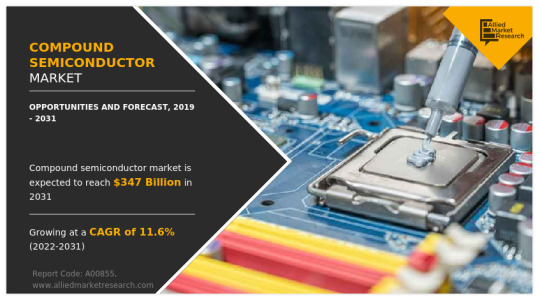
On the basis of product, the compound semiconductor market size is categorized into power semiconductors, transistors, integrated circuits (ICs), diodes & rectifiers, and others. The transistors segment is further classified into high electron mobility transistors (HEMTs), metal oxide semiconductor field effect transistors (MOSFETs), and metal-semiconductor field effect transistors (MESFETs). The integrated circuit is bifurcated into monolithic microwave integrated circuits (MMICs) and radio frequency integrated circuits (RFICs). The diode & rectifiers segment is further segmented into PIN diode, Zener diode, Schottky diode, and light emitting diode. By deposition technology, the market is segmented into chemical vapor deposition (CVD), molecular beam epitaxy (MBE), hydride vapor phase epitaxy (HVPE), ammonothermal, liquid phase epitaxy (LPE), atomic layer deposition (ALD), and others.
On the basis of applications, the compound semiconductor market analysis is segregated into IT & telecom, industrial and energy & power, aerospace & defense, automotive, consumer electronics, and healthcare. IT & telecom is further segmented into signal amplifiers & switching systems, satellite communication applications, radar applications, and RF. Aerospace & defense is classified into combat vehicles, ships & vessels, and microwave radiation. Industrial and energy & power are further segmented into wind turbines and wind power systems. Consumer electronics is further segmented into inverters, LED lighting, and switch-mode consumer power supply systems. The automotive segment is further divided into electric vehicles & hybrid electric vehicles, automotive braking systems, rail traction, and automobile motor drives. The healthcare segment is further bifurcated into implantable medical devices and biomedical electronics.
Region-wise, the compound semiconductor market trends are analyzed across North America (the U.S., Canada, and Mexico), Europe (UK, Germany, France, and the rest of Europe), Asia-Pacific (China, Japan, India, Australia, and the rest of the Asia-Pacific), and LAMEA (Latin America, the Middle East, and Africa).
KEY FINDINGS OF THE STUDY
The IV-IV compound semiconductor segment dominated the compound semiconductor market growth, in terms of revenue, and is expected to follow the same trend during the forecast period.
The power semiconductor segment was the highest revenue contributor to the market in 2021, and it is anticipated to grow at a significant CAGR during the forecast period.
The chemical vapor deposition and molecular beam epitaxy segments collectively accounted for around 42.7% market share in 2019, with the former constituting around 23.5% share
The IT and telecom segment was the highest revenue contributor to the market in 2021.
Asia-Pacific and North America collectively accounted for around 74.2% share in 2019, with the former constituting around 51.37% share.
The key players profiled in the report include Cree Inc., Infineon Technologies AG, Nichia Corporation, NXP Semiconductor N.V., Qorvo, Renesas Electronics Corporation, Samsung Electronics, STMicroelectronics NV, Taiwan Semiconductor Manufacturing Company Ltd., and Texas Instruments Inc. These players have adopted various strategies such as product launch, acquisition, partnership, and expansion to expand their foothold in the industry.
#semiconductors#Compound Semiconductor#electronics#battery#black sapphire cookie#black sapphire crk#star sapphire#transistor radio
0 notes
Text
Semiconductor Components Company

When a semiconductor is composed of small crystals of crystalline compounds, it is referred to as a microcrystalline or amorphous semiconductor material. Strictly speaking, a semiconductor is not a component but a material that has a conductivity between that of conductors and insulators. Semiconductors are important because they can be constructed to conduct electricity better than other materials, a fact which makes them perfect for many applications. The unique properties of semiconductors position them in between high-conducting materials like copper or aluminum and nonconductors like rubber or glass. Most commonly made out of silicon, germanium and gallium arsenide, semiconducting hardware either allows a free-flowing current or repels it completely - semiconductor components.
Exposing a semiconductor to light can produce electron hole pairs, which increases the number of free carriers and thereby the conductivity. Compound semiconductor diodes are also being used to generate light, light-emitting diodes and laser diodes. Semiconductors are materials that conduct electricity well enough to be used in transistors and other electronic devices, but not quite as well as metal. Semiconductors are used to build virtually every electronic device and have applications across most relevant sectors, such as automotive, home electronics, communications equipment and enterprise systems. In other words, if you want to enhance conductivity, you need to add more electrons, or more holes anything to create an unequal number of either instance - EMC Solution.
They are typically used as amplifiers and oscillators in high-frequency microwave electronic devices. The main advantage of a semiconductor is its ability to control the flow of electrical current electrical charges. The conductors lack this ability as they allow current to flow in both directions. Now let us talk about the important category of material for our discussion i.e. the semiconductors. We use these discrete components in power devices, compactness optical sensors, and light emitters. In addition, they have an extensive range of current and voltage handling capabilities. For more information, please visit our site https://www.westek.com.au/
0 notes